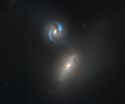NGC 1409
| Galaxie NGC 1409 | |
|---|---|
 | |
| NGC 1409 (unten) und NGC 1410 (oben) aufgenommen vom Hubble-Weltraumteleskop | |
| AladinLite | |
| Sternbild | Stier |
| Position Äquinoktium: J2000.0, Epoche: J2000.0 | |
| Rektaszension | 03h 41m 10,4s [1] |
| Deklination | −01° 18′ 09″ [1] |
| Erscheinungsbild | |
| Morphologischer Typ | SAB pec / Sy2[1] |
| Helligkeit (visuell) | 13,7 mag[2] |
| Helligkeit (B-Band) | 14,7 mag[2] |
| Winkelausdehnung | 1′ × 0,8′[2] |
| Positionswinkel | 130°[2] |
| Flächenhelligkeit | 13,3 mag/arcmin²[2] |
| Physikalische Daten | |
| Rotverschiebung | 0.025851 ± 0.000133[1] |
| Radialgeschwindigkeit | (7750 ± 40) km/s[1] |
| Hubbledistanz H0 = 73 km/(s • Mpc) | (345 ± 24) · 106 Lj (105,7 ± 7,4) Mpc [1] |
| Durchmesser | 100.000 Lj[3] |
| Geschichte | |
| Entdeckung | Wilhelm Herschel |
| Entdeckungsdatum | 6. Januar 1785 |
| Katalogbezeichnungen | |
| NGC 1409 • UGC 2821 • PGC 13553 • CGCG 391-028 NED01 • MCG +00-10-011 • 2MASX J03411054-0118101 • GC 753 • H III 263 • h 304 • KPG 93A • VV 729a • III Zw 55 | |
NGC 1409 ist eine Spiralgalaxie vom Hubble-Typ SAB im Sternbild Stier, die 345 Millionen Lichtjahre von der Milchstraße entfernt ist. Sie befindet sich in Wechselwirkung mit der Galaxie NGC 1410, von der sie rund 23.000 Lichtjahre entfernt ist. Es wird vermutet, dass die beiden Galaxien vor etwa 100 Millionen Jahren kollidierten und dass sie in ca. 200 Millionen Jahren verschmelzen werden.
Die Galaxie wurde am 6. Januar 1785 vom deutsch-britischen Astronomen Wilhelm Herschel entdeckt.[4]
Weblinks
- Astronomie.de ( vom 5. Februar 2009 im Internet Archive)
- Wechselwirkende Galaxien
- goBlack
- NGC 1410/1409: Intergalactic Pipeline – Astronomy Picture of the Day vom 12. Januar 2001 (englisch).
- Astronews
- Mass Transfer in the Galaxy Pair NGC 1409/10
- SIMBAD Astronomical Database
- CDS Portal
Einzelnachweise
Auf dieser Seite verwendete Medien
Autor/Urheber: Judy Schmidt from USA, Lizenz: CC BY 2.0
Two interacting galaxies, one a spiral with a tendril of dust seemingly being pulled out and wrapping around the other, an older, yellower, smoother galaxy.
h/t to William Keel, who was also the PI, for this rare color STIS picture.
This image is a reprocessed version of the following image, intended to offer some improvements to the quality: hubblesite.org/contents/media/images/2001/02/1013-Image.h...
Data from the following proposal were used to create this image: Subarcsecond Structure in Nearby AGNs
Note color is approximate for the outer left and right part of the image. The filters only overlapped the broad central area.
Red: STIS/CCD F28X50LPMIRVIS Green: pseudo Blue: STIS/CCD 50CCD MIRVIS
North is 4.66° counter-clockwise from up.